Accounting Theory and Corporate Governance: A Comparative Study
VerifiedAdded on 2023/04/23
|14
|2815
|94
Report
AI Summary
This report delves into the realms of accounting theory and corporate governance, offering a comprehensive analysis of key principles and practices. It begins with a comparative examination of corporate governance disclosures by Wesfarmers Limited and Woolworths Limited, scrutinizing board composition, director independence, and executive statements. The report then transitions into a broader discussion of corporate governance, defining its role in directing and controlling organizations, balancing stakeholder interests, and ensuring transparency. A significant portion is dedicated to the impact of CLERP 9, analyzing its modifications to the Corporations Act 2001 and its effects on financial reporting, executive remuneration, and analyst independence. The report also explores corporate governance failures, using the National Australia Bank (NAB) and One.Tel as case studies, highlighting the consequences of poor governance. Finally, it examines the emergence of integrated reporting and its role in representing financial and non-financial performance, including ESG factors, and the drivers behind its adoption, concluding with a discussion on its potential to enhance long-term value creation and stakeholder engagement. The report provides valuable insights into the evolution and importance of corporate governance in the modern business environment.
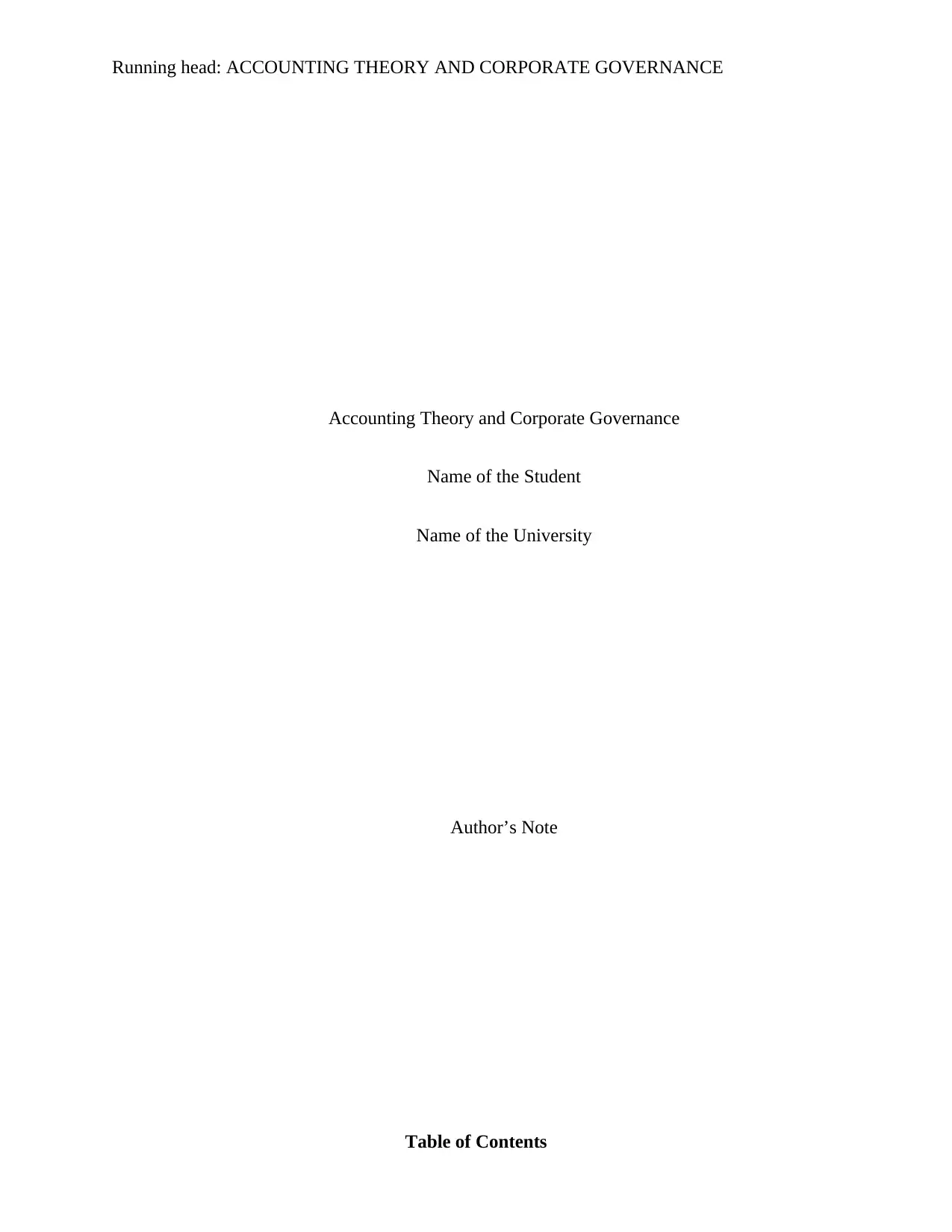
Running head: ACCOUNTING THEORY AND CORPORATE GOVERNANCE
Accounting Theory and Corporate Governance
Name of the Student
Name of the University
Author’s Note
Table of Contents
Accounting Theory and Corporate Governance
Name of the Student
Name of the University
Author’s Note
Table of Contents
Paraphrase This Document
Need a fresh take? Get an instant paraphrase of this document with our AI Paraphraser
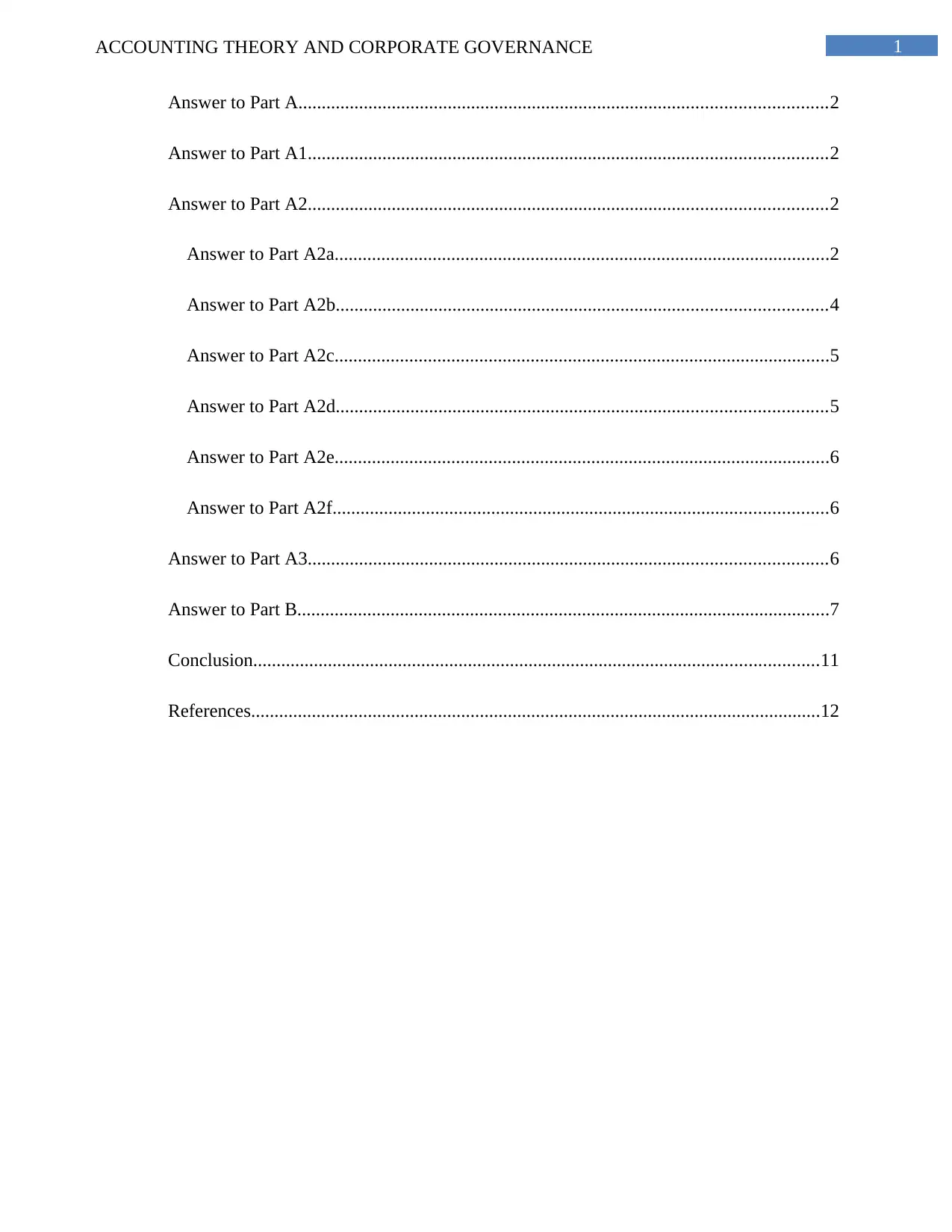
1ACCOUNTING THEORY AND CORPORATE GOVERNANCE
Answer to Part A.................................................................................................................2
Answer to Part A1...............................................................................................................2
Answer to Part A2...............................................................................................................2
Answer to Part A2a..........................................................................................................2
Answer to Part A2b.........................................................................................................4
Answer to Part A2c..........................................................................................................5
Answer to Part A2d.........................................................................................................5
Answer to Part A2e..........................................................................................................6
Answer to Part A2f..........................................................................................................6
Answer to Part A3...............................................................................................................6
Answer to Part B..................................................................................................................7
Conclusion.........................................................................................................................11
References..........................................................................................................................12
Answer to Part A.................................................................................................................2
Answer to Part A1...............................................................................................................2
Answer to Part A2...............................................................................................................2
Answer to Part A2a..........................................................................................................2
Answer to Part A2b.........................................................................................................4
Answer to Part A2c..........................................................................................................5
Answer to Part A2d.........................................................................................................5
Answer to Part A2e..........................................................................................................6
Answer to Part A2f..........................................................................................................6
Answer to Part A3...............................................................................................................6
Answer to Part B..................................................................................................................7
Conclusion.........................................................................................................................11
References..........................................................................................................................12
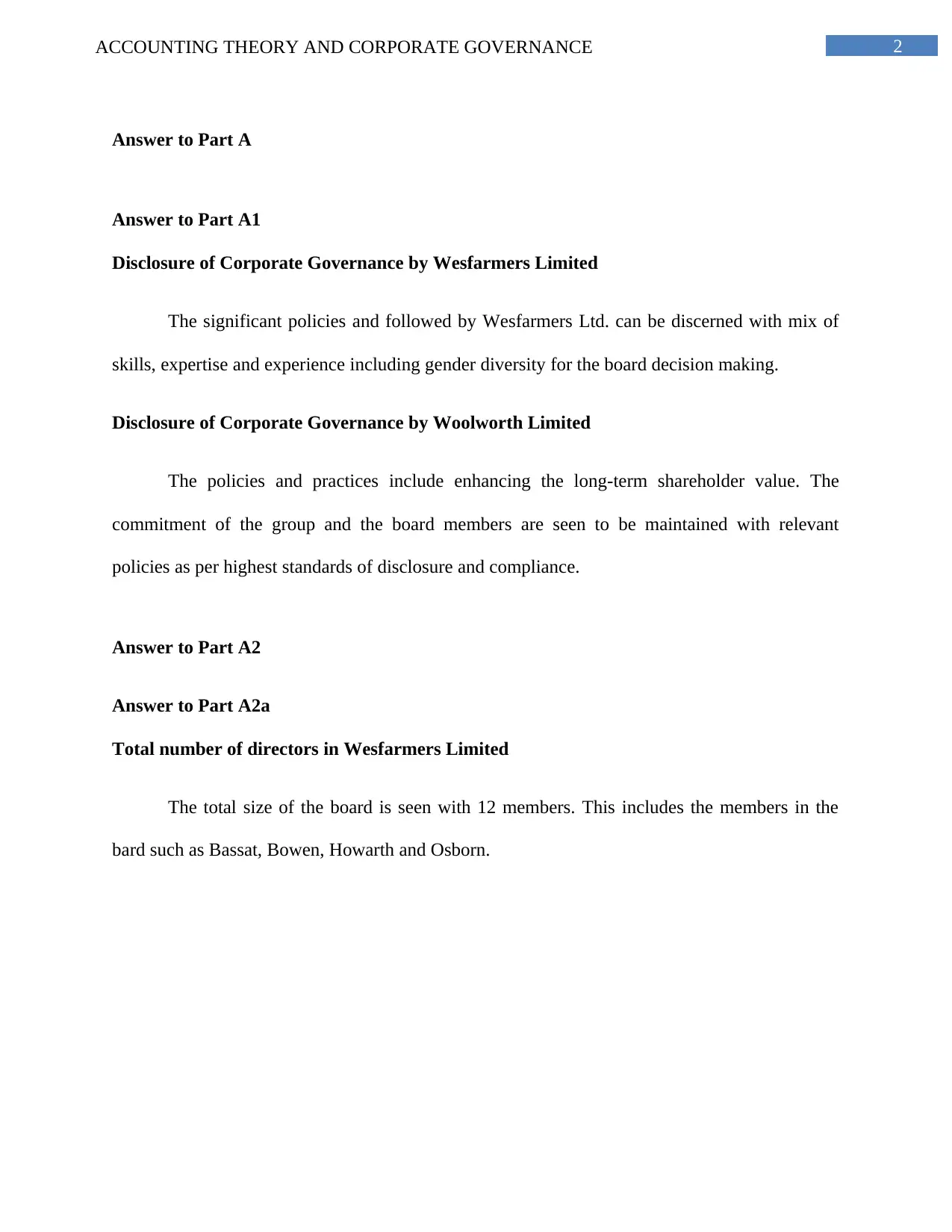
2ACCOUNTING THEORY AND CORPORATE GOVERNANCE
Answer to Part A
Answer to Part A1
Disclosure of Corporate Governance by Wesfarmers Limited
The significant policies and followed by Wesfarmers Ltd. can be discerned with mix of
skills, expertise and experience including gender diversity for the board decision making.
Disclosure of Corporate Governance by Woolworth Limited
The policies and practices include enhancing the long-term shareholder value. The
commitment of the group and the board members are seen to be maintained with relevant
policies as per highest standards of disclosure and compliance.
Answer to Part A2
Answer to Part A2a
Total number of directors in Wesfarmers Limited
The total size of the board is seen with 12 members. This includes the members in the
bard such as Bassat, Bowen, Howarth and Osborn.
Answer to Part A
Answer to Part A1
Disclosure of Corporate Governance by Wesfarmers Limited
The significant policies and followed by Wesfarmers Ltd. can be discerned with mix of
skills, expertise and experience including gender diversity for the board decision making.
Disclosure of Corporate Governance by Woolworth Limited
The policies and practices include enhancing the long-term shareholder value. The
commitment of the group and the board members are seen to be maintained with relevant
policies as per highest standards of disclosure and compliance.
Answer to Part A2
Answer to Part A2a
Total number of directors in Wesfarmers Limited
The total size of the board is seen with 12 members. This includes the members in the
bard such as Bassat, Bowen, Howarth and Osborn.
⊘ This is a preview!⊘
Do you want full access?
Subscribe today to unlock all pages.

Trusted by 1+ million students worldwide
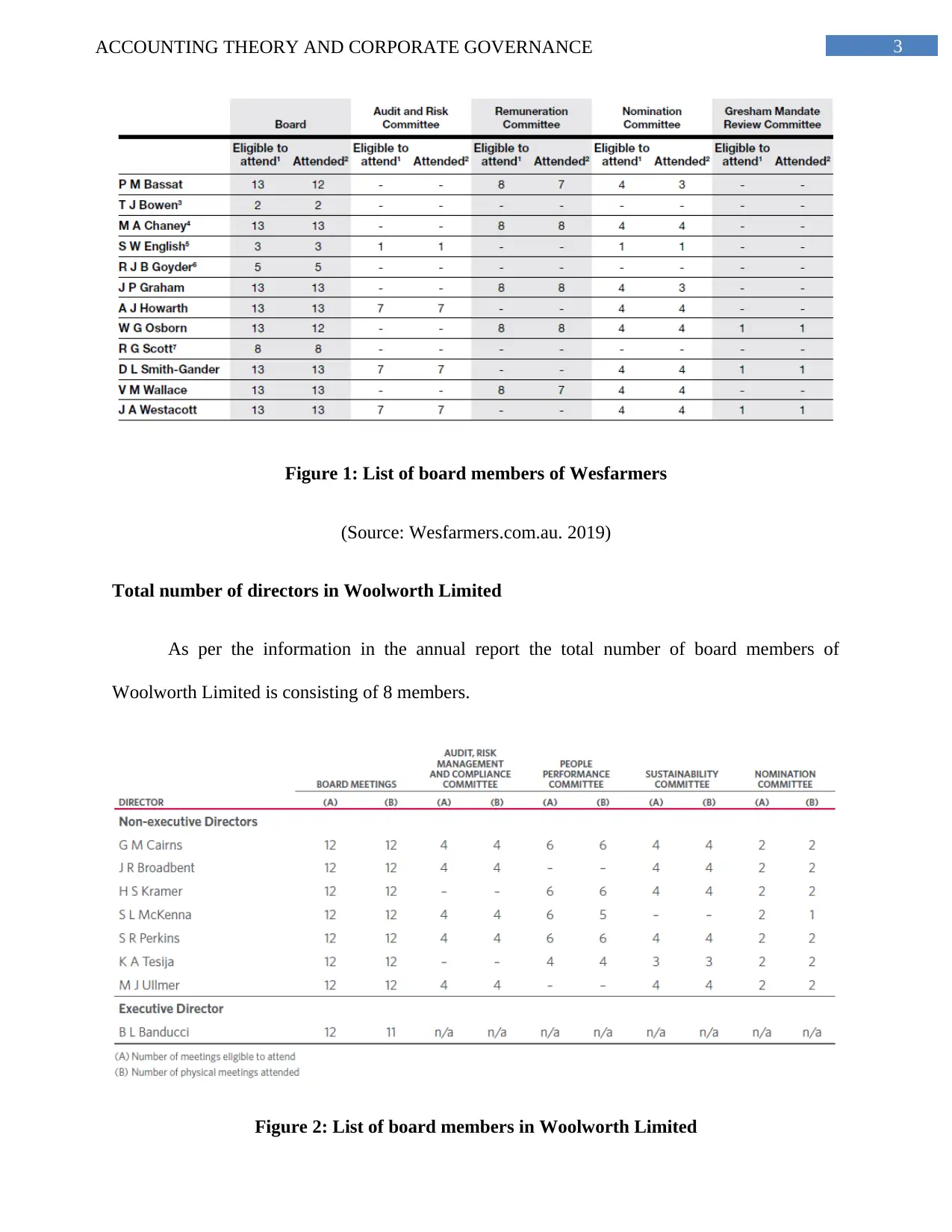
3ACCOUNTING THEORY AND CORPORATE GOVERNANCE
Figure 1: List of board members of Wesfarmers
(Source: Wesfarmers.com.au. 2019)
Total number of directors in Woolworth Limited
As per the information in the annual report the total number of board members of
Woolworth Limited is consisting of 8 members.
Figure 2: List of board members in Woolworth Limited
Figure 1: List of board members of Wesfarmers
(Source: Wesfarmers.com.au. 2019)
Total number of directors in Woolworth Limited
As per the information in the annual report the total number of board members of
Woolworth Limited is consisting of 8 members.
Figure 2: List of board members in Woolworth Limited
Paraphrase This Document
Need a fresh take? Get an instant paraphrase of this document with our AI Paraphraser
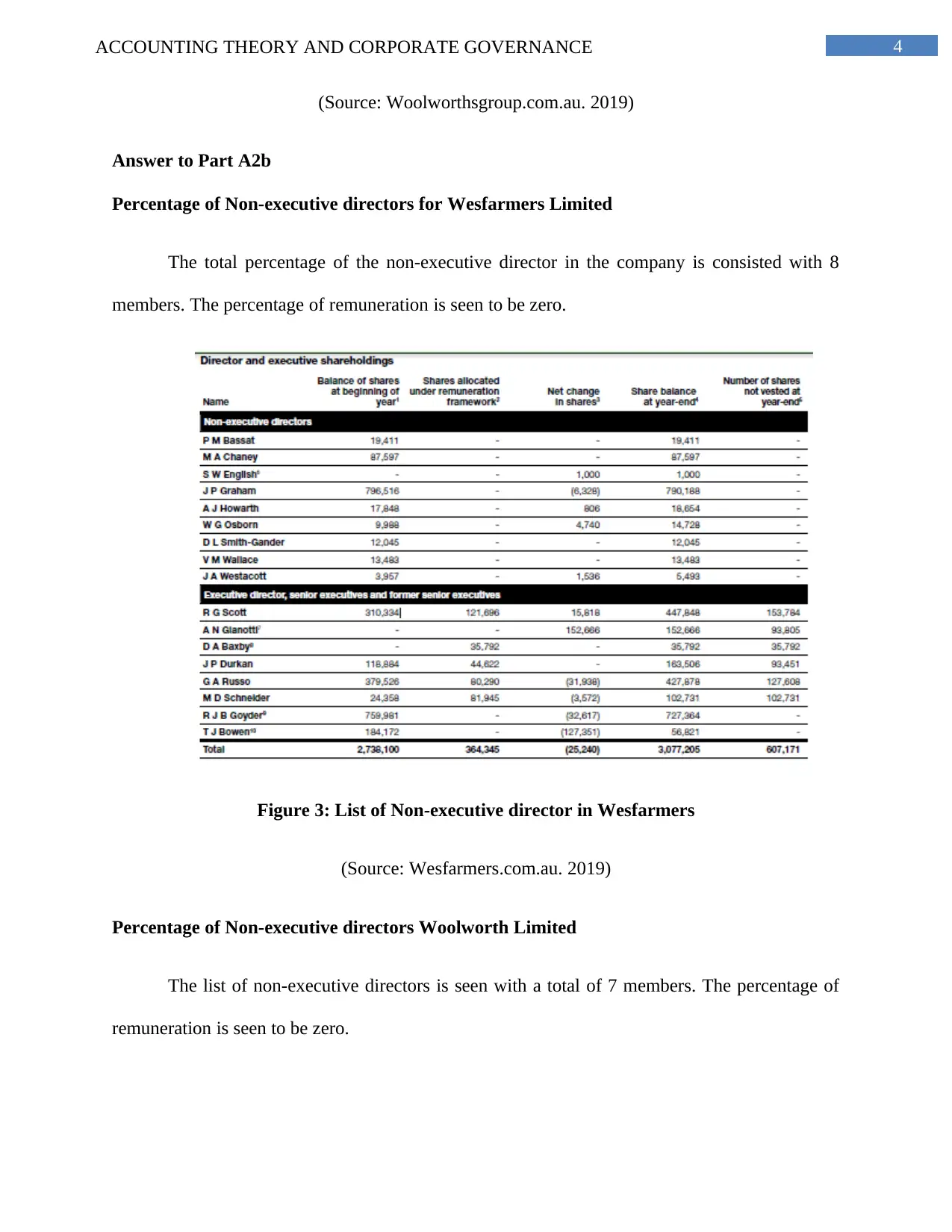
4ACCOUNTING THEORY AND CORPORATE GOVERNANCE
(Source: Woolworthsgroup.com.au. 2019)
Answer to Part A2b
Percentage of Non-executive directors for Wesfarmers Limited
The total percentage of the non-executive director in the company is consisted with 8
members. The percentage of remuneration is seen to be zero.
Figure 3: List of Non-executive director in Wesfarmers
(Source: Wesfarmers.com.au. 2019)
Percentage of Non-executive directors Woolworth Limited
The list of non-executive directors is seen with a total of 7 members. The percentage of
remuneration is seen to be zero.
(Source: Woolworthsgroup.com.au. 2019)
Answer to Part A2b
Percentage of Non-executive directors for Wesfarmers Limited
The total percentage of the non-executive director in the company is consisted with 8
members. The percentage of remuneration is seen to be zero.
Figure 3: List of Non-executive director in Wesfarmers
(Source: Wesfarmers.com.au. 2019)
Percentage of Non-executive directors Woolworth Limited
The list of non-executive directors is seen with a total of 7 members. The percentage of
remuneration is seen to be zero.
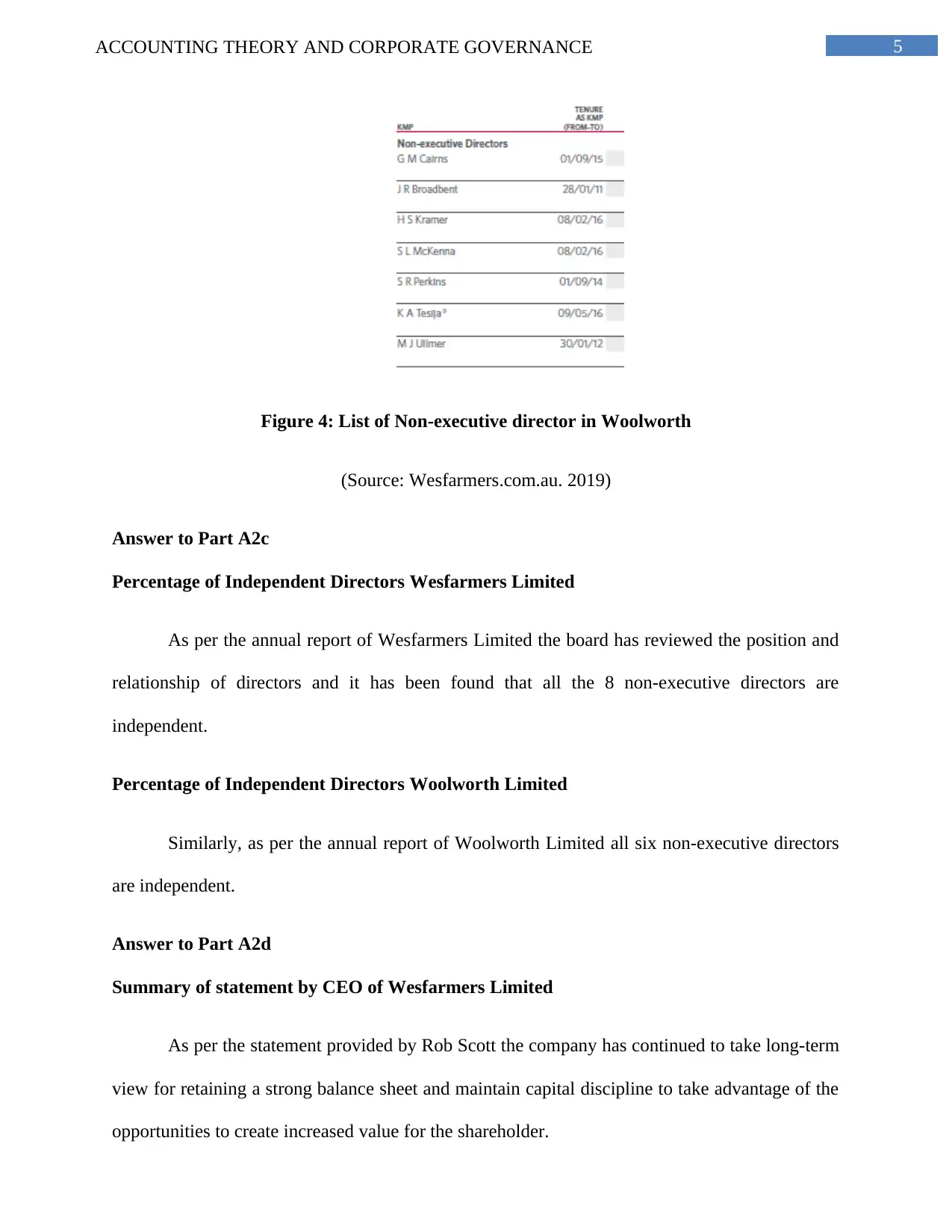
5ACCOUNTING THEORY AND CORPORATE GOVERNANCE
Figure 4: List of Non-executive director in Woolworth
(Source: Wesfarmers.com.au. 2019)
Answer to Part A2c
Percentage of Independent Directors Wesfarmers Limited
As per the annual report of Wesfarmers Limited the board has reviewed the position and
relationship of directors and it has been found that all the 8 non-executive directors are
independent.
Percentage of Independent Directors Woolworth Limited
Similarly, as per the annual report of Woolworth Limited all six non-executive directors
are independent.
Answer to Part A2d
Summary of statement by CEO of Wesfarmers Limited
As per the statement provided by Rob Scott the company has continued to take long-term
view for retaining a strong balance sheet and maintain capital discipline to take advantage of the
opportunities to create increased value for the shareholder.
Figure 4: List of Non-executive director in Woolworth
(Source: Wesfarmers.com.au. 2019)
Answer to Part A2c
Percentage of Independent Directors Wesfarmers Limited
As per the annual report of Wesfarmers Limited the board has reviewed the position and
relationship of directors and it has been found that all the 8 non-executive directors are
independent.
Percentage of Independent Directors Woolworth Limited
Similarly, as per the annual report of Woolworth Limited all six non-executive directors
are independent.
Answer to Part A2d
Summary of statement by CEO of Wesfarmers Limited
As per the statement provided by Rob Scott the company has continued to take long-term
view for retaining a strong balance sheet and maintain capital discipline to take advantage of the
opportunities to create increased value for the shareholder.
⊘ This is a preview!⊘
Do you want full access?
Subscribe today to unlock all pages.

Trusted by 1+ million students worldwide

6ACCOUNTING THEORY AND CORPORATE GOVERNANCE
Summary of statement by CEO of Woolworth Limited
CEO Brad Banducci has identified creating better experiences in the company by
listening to the customers and bring transformation in food business division across Australia
and New Zealand.
Answer to Part A2e
The non-executive directors are seen to hold any shares for both the companies.
Answer to Part A2f
Institutional Shareholders of Wesfarmers
Among the largest shareholders it can be identified that HSBC Custody Nominees
(Australia) Limited is holding 23% of issues share capital, J P Morgan Nominees Australia
Limited is holding 15.15% and Citicorp Nominees Pty Limited with 5.31%.
Institutional Shareholders of Woolworth
The largest institutional shareholders may be discerned in terms of HSBC Custody
Nominees (Australia) Limited with percentage total shares issued with 24.16%, JP Morgan
Nominees Australia Limited with 15.10%, BNP Paribas Nominees Pty Ltd with 6.76% and
Citicorp Nominees Pty Limited with 5.64%.
Answer to Part A3
Comparison of CG principles:
Basis of comparison Wesfarmers Ltd Woolworth ltd.
Effectiveness Effective disclosure of
Regulatory and government
policy, CEO level experience, E-
Elaborate Summary of retail
markets, governance,
Summary of statement by CEO of Woolworth Limited
CEO Brad Banducci has identified creating better experiences in the company by
listening to the customers and bring transformation in food business division across Australia
and New Zealand.
Answer to Part A2e
The non-executive directors are seen to hold any shares for both the companies.
Answer to Part A2f
Institutional Shareholders of Wesfarmers
Among the largest shareholders it can be identified that HSBC Custody Nominees
(Australia) Limited is holding 23% of issues share capital, J P Morgan Nominees Australia
Limited is holding 15.15% and Citicorp Nominees Pty Limited with 5.31%.
Institutional Shareholders of Woolworth
The largest institutional shareholders may be discerned in terms of HSBC Custody
Nominees (Australia) Limited with percentage total shares issued with 24.16%, JP Morgan
Nominees Australia Limited with 15.10%, BNP Paribas Nominees Pty Ltd with 6.76% and
Citicorp Nominees Pty Limited with 5.64%.
Answer to Part A3
Comparison of CG principles:
Basis of comparison Wesfarmers Ltd Woolworth ltd.
Effectiveness Effective disclosure of
Regulatory and government
policy, CEO level experience, E-
Elaborate Summary of retail
markets, governance,
Paraphrase This Document
Need a fresh take? Get an instant paraphrase of this document with our AI Paraphraser
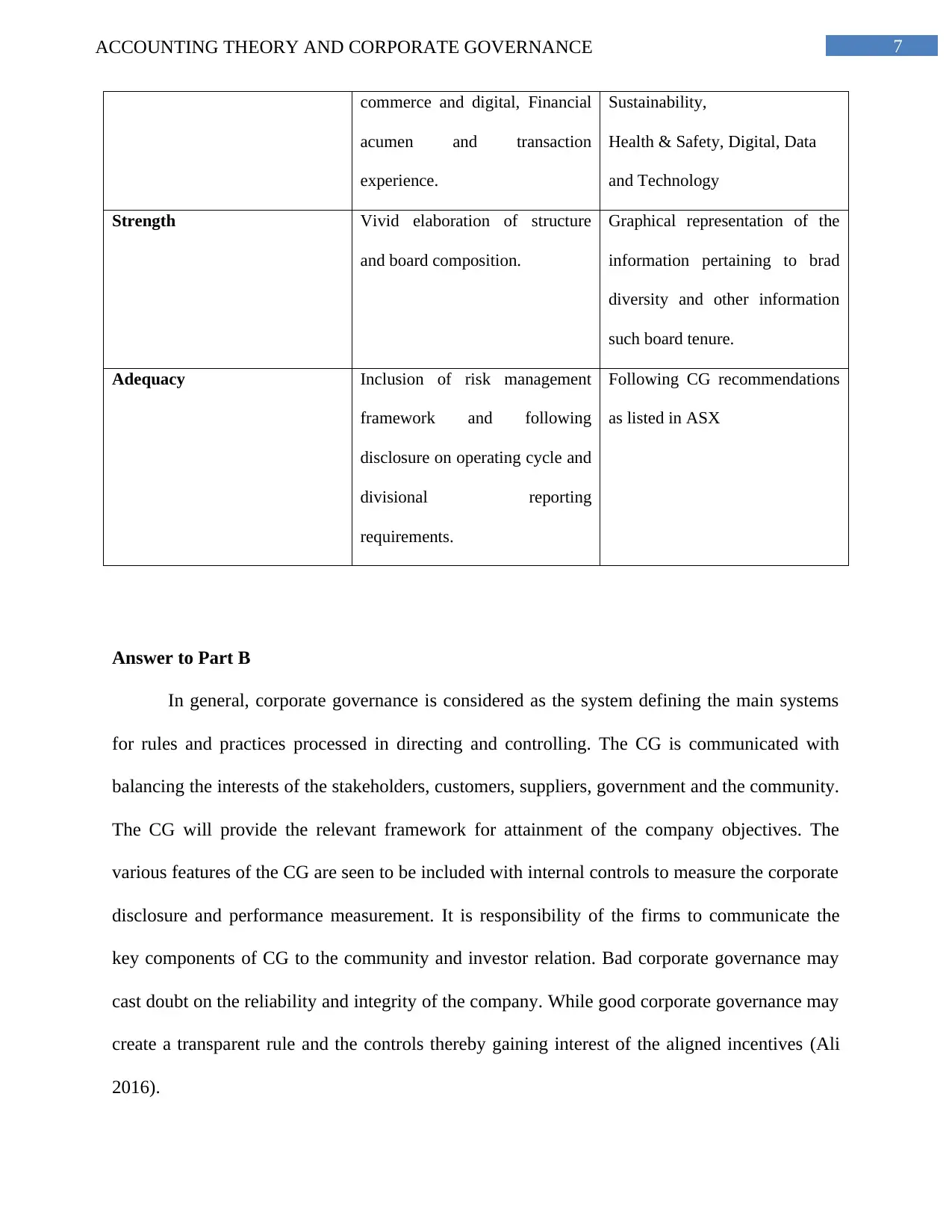
7ACCOUNTING THEORY AND CORPORATE GOVERNANCE
commerce and digital, Financial
acumen and transaction
experience.
Sustainability,
Health & Safety, Digital, Data
and Technology
Strength Vivid elaboration of structure
and board composition.
Graphical representation of the
information pertaining to brad
diversity and other information
such board tenure.
Adequacy Inclusion of risk management
framework and following
disclosure on operating cycle and
divisional reporting
requirements.
Following CG recommendations
as listed in ASX
Answer to Part B
In general, corporate governance is considered as the system defining the main systems
for rules and practices processed in directing and controlling. The CG is communicated with
balancing the interests of the stakeholders, customers, suppliers, government and the community.
The CG will provide the relevant framework for attainment of the company objectives. The
various features of the CG are seen to be included with internal controls to measure the corporate
disclosure and performance measurement. It is responsibility of the firms to communicate the
key components of CG to the community and investor relation. Bad corporate governance may
cast doubt on the reliability and integrity of the company. While good corporate governance may
create a transparent rule and the controls thereby gaining interest of the aligned incentives (Ali
2016).
commerce and digital, Financial
acumen and transaction
experience.
Sustainability,
Health & Safety, Digital, Data
and Technology
Strength Vivid elaboration of structure
and board composition.
Graphical representation of the
information pertaining to brad
diversity and other information
such board tenure.
Adequacy Inclusion of risk management
framework and following
disclosure on operating cycle and
divisional reporting
requirements.
Following CG recommendations
as listed in ASX
Answer to Part B
In general, corporate governance is considered as the system defining the main systems
for rules and practices processed in directing and controlling. The CG is communicated with
balancing the interests of the stakeholders, customers, suppliers, government and the community.
The CG will provide the relevant framework for attainment of the company objectives. The
various features of the CG are seen to be included with internal controls to measure the corporate
disclosure and performance measurement. It is responsibility of the firms to communicate the
key components of CG to the community and investor relation. Bad corporate governance may
cast doubt on the reliability and integrity of the company. While good corporate governance may
create a transparent rule and the controls thereby gaining interest of the aligned incentives (Ali
2016).
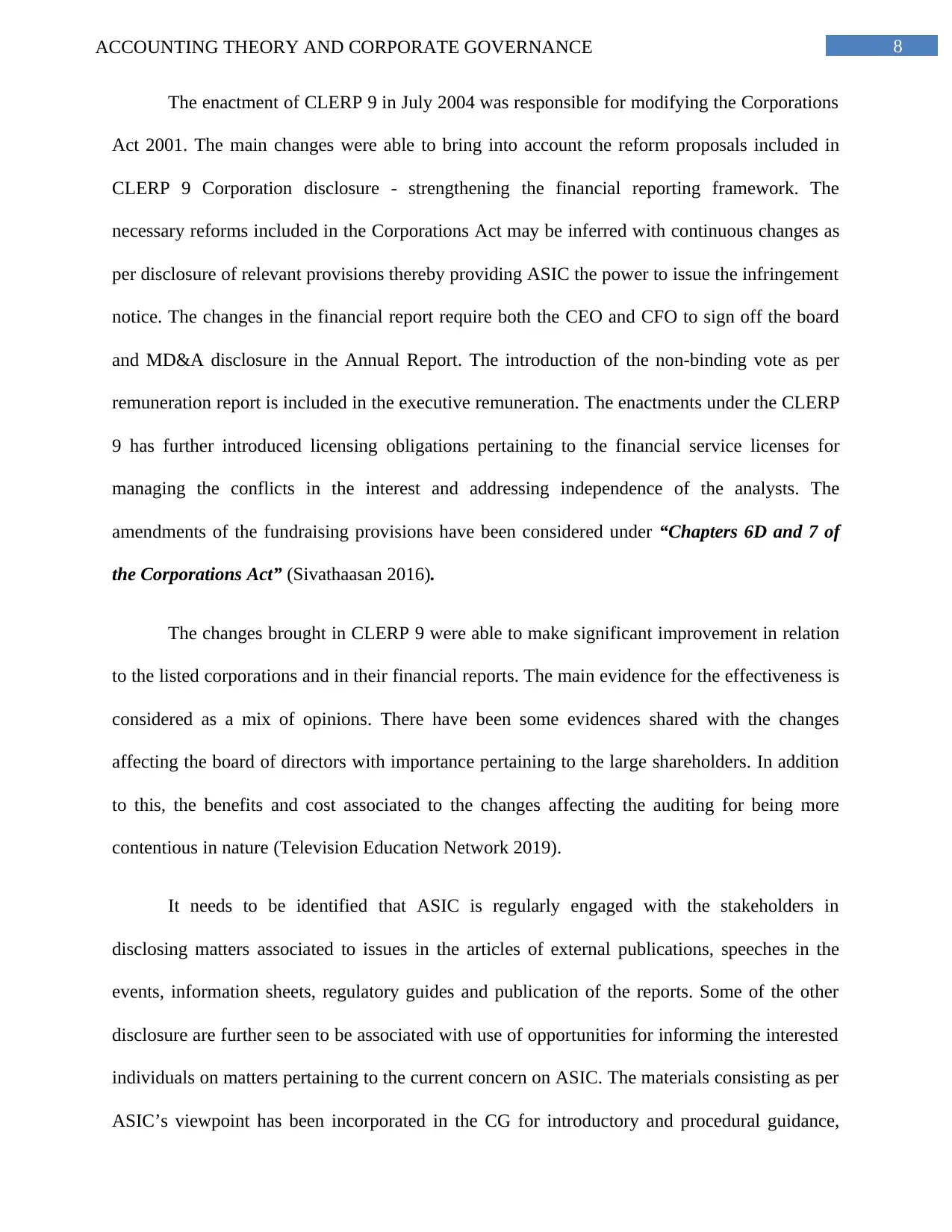
8ACCOUNTING THEORY AND CORPORATE GOVERNANCE
The enactment of CLERP 9 in July 2004 was responsible for modifying the Corporations
Act 2001. The main changes were able to bring into account the reform proposals included in
CLERP 9 Corporation disclosure - strengthening the financial reporting framework. The
necessary reforms included in the Corporations Act may be inferred with continuous changes as
per disclosure of relevant provisions thereby providing ASIC the power to issue the infringement
notice. The changes in the financial report require both the CEO and CFO to sign off the board
and MD&A disclosure in the Annual Report. The introduction of the non-binding vote as per
remuneration report is included in the executive remuneration. The enactments under the CLERP
9 has further introduced licensing obligations pertaining to the financial service licenses for
managing the conflicts in the interest and addressing independence of the analysts. The
amendments of the fundraising provisions have been considered under “Chapters 6D and 7 of
the Corporations Act” (Sivathaasan 2016).
The changes brought in CLERP 9 were able to make significant improvement in relation
to the listed corporations and in their financial reports. The main evidence for the effectiveness is
considered as a mix of opinions. There have been some evidences shared with the changes
affecting the board of directors with importance pertaining to the large shareholders. In addition
to this, the benefits and cost associated to the changes affecting the auditing for being more
contentious in nature (Television Education Network 2019).
It needs to be identified that ASIC is regularly engaged with the stakeholders in
disclosing matters associated to issues in the articles of external publications, speeches in the
events, information sheets, regulatory guides and publication of the reports. Some of the other
disclosure are further seen to be associated with use of opportunities for informing the interested
individuals on matters pertaining to the current concern on ASIC. The materials consisting as per
ASIC’s viewpoint has been incorporated in the CG for introductory and procedural guidance,
The enactment of CLERP 9 in July 2004 was responsible for modifying the Corporations
Act 2001. The main changes were able to bring into account the reform proposals included in
CLERP 9 Corporation disclosure - strengthening the financial reporting framework. The
necessary reforms included in the Corporations Act may be inferred with continuous changes as
per disclosure of relevant provisions thereby providing ASIC the power to issue the infringement
notice. The changes in the financial report require both the CEO and CFO to sign off the board
and MD&A disclosure in the Annual Report. The introduction of the non-binding vote as per
remuneration report is included in the executive remuneration. The enactments under the CLERP
9 has further introduced licensing obligations pertaining to the financial service licenses for
managing the conflicts in the interest and addressing independence of the analysts. The
amendments of the fundraising provisions have been considered under “Chapters 6D and 7 of
the Corporations Act” (Sivathaasan 2016).
The changes brought in CLERP 9 were able to make significant improvement in relation
to the listed corporations and in their financial reports. The main evidence for the effectiveness is
considered as a mix of opinions. There have been some evidences shared with the changes
affecting the board of directors with importance pertaining to the large shareholders. In addition
to this, the benefits and cost associated to the changes affecting the auditing for being more
contentious in nature (Television Education Network 2019).
It needs to be identified that ASIC is regularly engaged with the stakeholders in
disclosing matters associated to issues in the articles of external publications, speeches in the
events, information sheets, regulatory guides and publication of the reports. Some of the other
disclosure are further seen to be associated with use of opportunities for informing the interested
individuals on matters pertaining to the current concern on ASIC. The materials consisting as per
ASIC’s viewpoint has been incorporated in the CG for introductory and procedural guidance,
⊘ This is a preview!⊘
Do you want full access?
Subscribe today to unlock all pages.

Trusted by 1+ million students worldwide
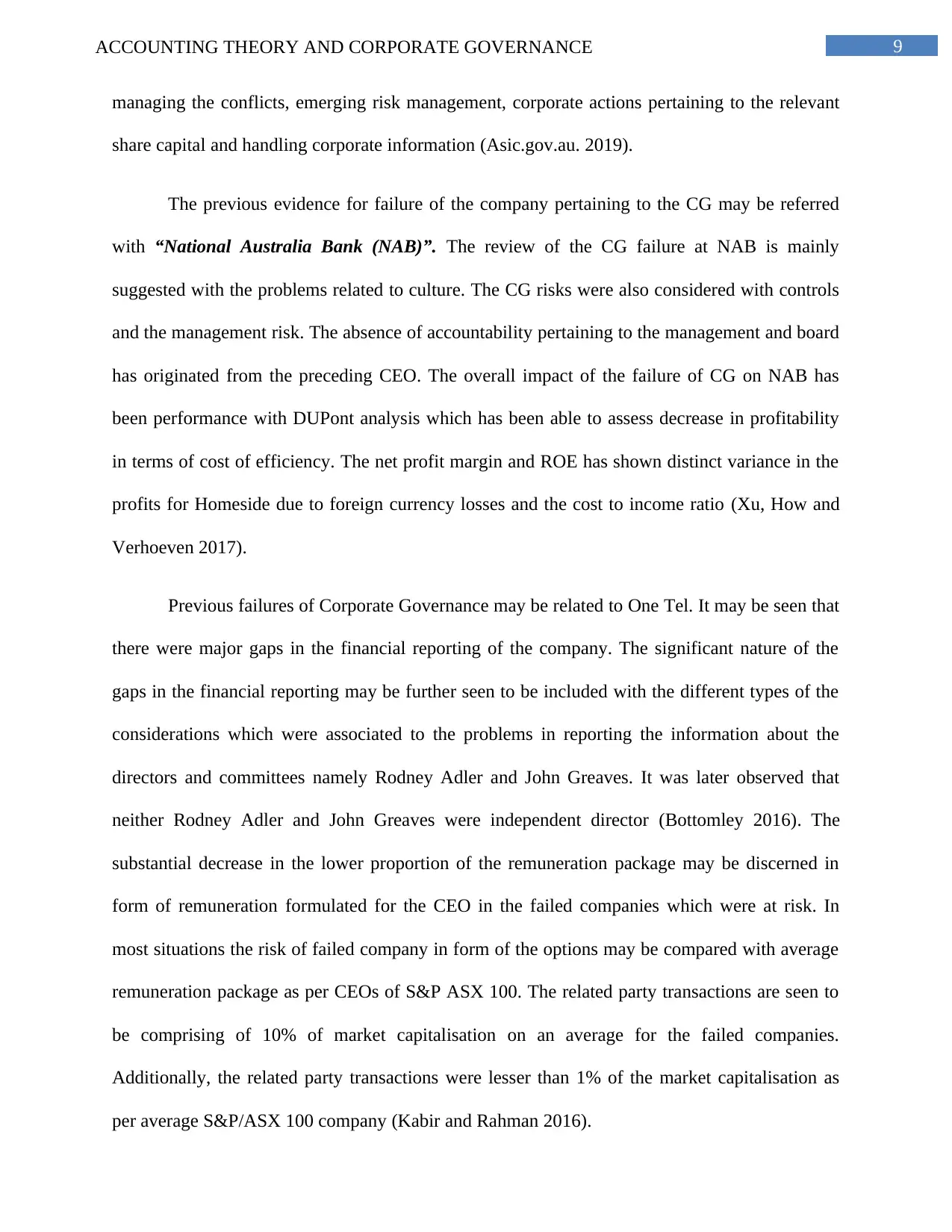
9ACCOUNTING THEORY AND CORPORATE GOVERNANCE
managing the conflicts, emerging risk management, corporate actions pertaining to the relevant
share capital and handling corporate information (Asic.gov.au. 2019).
The previous evidence for failure of the company pertaining to the CG may be referred
with “National Australia Bank (NAB)”. The review of the CG failure at NAB is mainly
suggested with the problems related to culture. The CG risks were also considered with controls
and the management risk. The absence of accountability pertaining to the management and board
has originated from the preceding CEO. The overall impact of the failure of CG on NAB has
been performance with DUPont analysis which has been able to assess decrease in profitability
in terms of cost of efficiency. The net profit margin and ROE has shown distinct variance in the
profits for Homeside due to foreign currency losses and the cost to income ratio (Xu, How and
Verhoeven 2017).
Previous failures of Corporate Governance may be related to One Tel. It may be seen that
there were major gaps in the financial reporting of the company. The significant nature of the
gaps in the financial reporting may be further seen to be included with the different types of the
considerations which were associated to the problems in reporting the information about the
directors and committees namely Rodney Adler and John Greaves. It was later observed that
neither Rodney Adler and John Greaves were independent director (Bottomley 2016). The
substantial decrease in the lower proportion of the remuneration package may be discerned in
form of remuneration formulated for the CEO in the failed companies which were at risk. In
most situations the risk of failed company in form of the options may be compared with average
remuneration package as per CEOs of S&P ASX 100. The related party transactions are seen to
be comprising of 10% of market capitalisation on an average for the failed companies.
Additionally, the related party transactions were lesser than 1% of the market capitalisation as
per average S&P/ASX 100 company (Kabir and Rahman 2016).
managing the conflicts, emerging risk management, corporate actions pertaining to the relevant
share capital and handling corporate information (Asic.gov.au. 2019).
The previous evidence for failure of the company pertaining to the CG may be referred
with “National Australia Bank (NAB)”. The review of the CG failure at NAB is mainly
suggested with the problems related to culture. The CG risks were also considered with controls
and the management risk. The absence of accountability pertaining to the management and board
has originated from the preceding CEO. The overall impact of the failure of CG on NAB has
been performance with DUPont analysis which has been able to assess decrease in profitability
in terms of cost of efficiency. The net profit margin and ROE has shown distinct variance in the
profits for Homeside due to foreign currency losses and the cost to income ratio (Xu, How and
Verhoeven 2017).
Previous failures of Corporate Governance may be related to One Tel. It may be seen that
there were major gaps in the financial reporting of the company. The significant nature of the
gaps in the financial reporting may be further seen to be included with the different types of the
considerations which were associated to the problems in reporting the information about the
directors and committees namely Rodney Adler and John Greaves. It was later observed that
neither Rodney Adler and John Greaves were independent director (Bottomley 2016). The
substantial decrease in the lower proportion of the remuneration package may be discerned in
form of remuneration formulated for the CEO in the failed companies which were at risk. In
most situations the risk of failed company in form of the options may be compared with average
remuneration package as per CEOs of S&P ASX 100. The related party transactions are seen to
be comprising of 10% of market capitalisation on an average for the failed companies.
Additionally, the related party transactions were lesser than 1% of the market capitalisation as
per average S&P/ASX 100 company (Kabir and Rahman 2016).
Paraphrase This Document
Need a fresh take? Get an instant paraphrase of this document with our AI Paraphraser
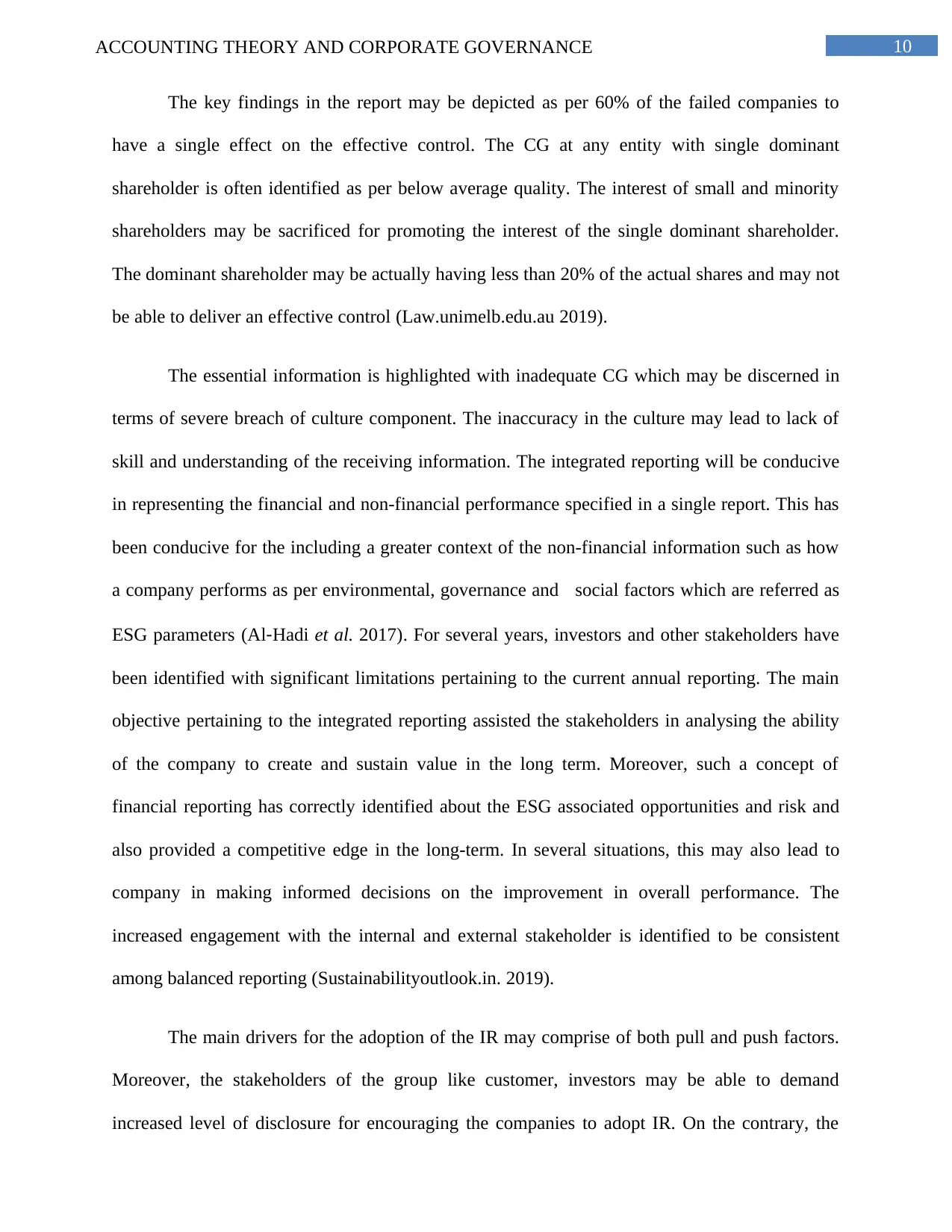
10ACCOUNTING THEORY AND CORPORATE GOVERNANCE
The key findings in the report may be depicted as per 60% of the failed companies to
have a single effect on the effective control. The CG at any entity with single dominant
shareholder is often identified as per below average quality. The interest of small and minority
shareholders may be sacrificed for promoting the interest of the single dominant shareholder.
The dominant shareholder may be actually having less than 20% of the actual shares and may not
be able to deliver an effective control (Law.unimelb.edu.au 2019).
The essential information is highlighted with inadequate CG which may be discerned in
terms of severe breach of culture component. The inaccuracy in the culture may lead to lack of
skill and understanding of the receiving information. The integrated reporting will be conducive
in representing the financial and non-financial performance specified in a single report. This has
been conducive for the including a greater context of the non-financial information such as how
a company performs as per environmental, governance and social factors which are referred as
ESG parameters (Al‐Hadi et al. 2017). For several years, investors and other stakeholders have
been identified with significant limitations pertaining to the current annual reporting. The main
objective pertaining to the integrated reporting assisted the stakeholders in analysing the ability
of the company to create and sustain value in the long term. Moreover, such a concept of
financial reporting has correctly identified about the ESG associated opportunities and risk and
also provided a competitive edge in the long-term. In several situations, this may also lead to
company in making informed decisions on the improvement in overall performance. The
increased engagement with the internal and external stakeholder is identified to be consistent
among balanced reporting (Sustainabilityoutlook.in. 2019).
The main drivers for the adoption of the IR may comprise of both pull and push factors.
Moreover, the stakeholders of the group like customer, investors may be able to demand
increased level of disclosure for encouraging the companies to adopt IR. On the contrary, the
The key findings in the report may be depicted as per 60% of the failed companies to
have a single effect on the effective control. The CG at any entity with single dominant
shareholder is often identified as per below average quality. The interest of small and minority
shareholders may be sacrificed for promoting the interest of the single dominant shareholder.
The dominant shareholder may be actually having less than 20% of the actual shares and may not
be able to deliver an effective control (Law.unimelb.edu.au 2019).
The essential information is highlighted with inadequate CG which may be discerned in
terms of severe breach of culture component. The inaccuracy in the culture may lead to lack of
skill and understanding of the receiving information. The integrated reporting will be conducive
in representing the financial and non-financial performance specified in a single report. This has
been conducive for the including a greater context of the non-financial information such as how
a company performs as per environmental, governance and social factors which are referred as
ESG parameters (Al‐Hadi et al. 2017). For several years, investors and other stakeholders have
been identified with significant limitations pertaining to the current annual reporting. The main
objective pertaining to the integrated reporting assisted the stakeholders in analysing the ability
of the company to create and sustain value in the long term. Moreover, such a concept of
financial reporting has correctly identified about the ESG associated opportunities and risk and
also provided a competitive edge in the long-term. In several situations, this may also lead to
company in making informed decisions on the improvement in overall performance. The
increased engagement with the internal and external stakeholder is identified to be consistent
among balanced reporting (Sustainabilityoutlook.in. 2019).
The main drivers for the adoption of the IR may comprise of both pull and push factors.
Moreover, the stakeholders of the group like customer, investors may be able to demand
increased level of disclosure for encouraging the companies to adopt IR. On the contrary, the
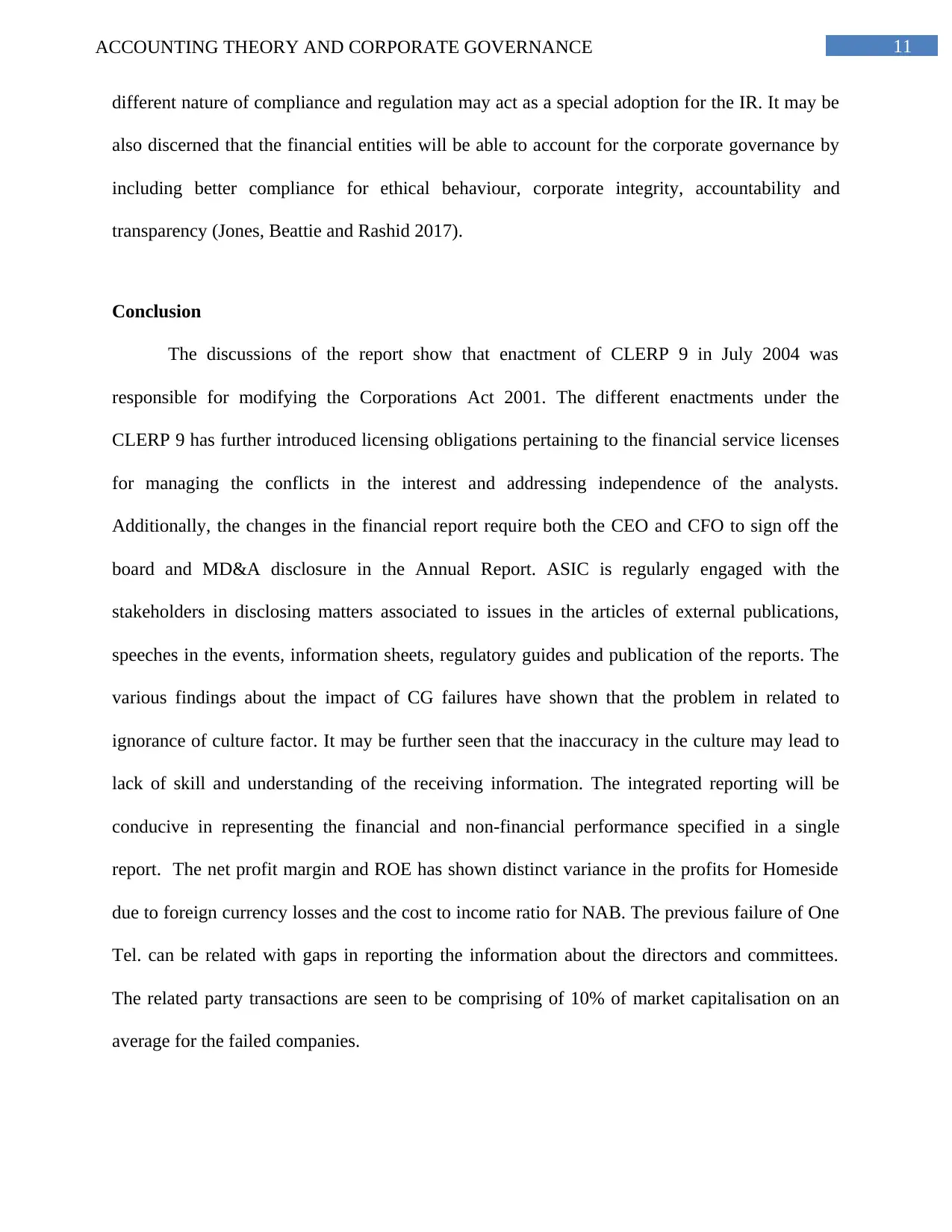
11ACCOUNTING THEORY AND CORPORATE GOVERNANCE
different nature of compliance and regulation may act as a special adoption for the IR. It may be
also discerned that the financial entities will be able to account for the corporate governance by
including better compliance for ethical behaviour, corporate integrity, accountability and
transparency (Jones, Beattie and Rashid 2017).
Conclusion
The discussions of the report show that enactment of CLERP 9 in July 2004 was
responsible for modifying the Corporations Act 2001. The different enactments under the
CLERP 9 has further introduced licensing obligations pertaining to the financial service licenses
for managing the conflicts in the interest and addressing independence of the analysts.
Additionally, the changes in the financial report require both the CEO and CFO to sign off the
board and MD&A disclosure in the Annual Report. ASIC is regularly engaged with the
stakeholders in disclosing matters associated to issues in the articles of external publications,
speeches in the events, information sheets, regulatory guides and publication of the reports. The
various findings about the impact of CG failures have shown that the problem in related to
ignorance of culture factor. It may be further seen that the inaccuracy in the culture may lead to
lack of skill and understanding of the receiving information. The integrated reporting will be
conducive in representing the financial and non-financial performance specified in a single
report. The net profit margin and ROE has shown distinct variance in the profits for Homeside
due to foreign currency losses and the cost to income ratio for NAB. The previous failure of One
Tel. can be related with gaps in reporting the information about the directors and committees.
The related party transactions are seen to be comprising of 10% of market capitalisation on an
average for the failed companies.
different nature of compliance and regulation may act as a special adoption for the IR. It may be
also discerned that the financial entities will be able to account for the corporate governance by
including better compliance for ethical behaviour, corporate integrity, accountability and
transparency (Jones, Beattie and Rashid 2017).
Conclusion
The discussions of the report show that enactment of CLERP 9 in July 2004 was
responsible for modifying the Corporations Act 2001. The different enactments under the
CLERP 9 has further introduced licensing obligations pertaining to the financial service licenses
for managing the conflicts in the interest and addressing independence of the analysts.
Additionally, the changes in the financial report require both the CEO and CFO to sign off the
board and MD&A disclosure in the Annual Report. ASIC is regularly engaged with the
stakeholders in disclosing matters associated to issues in the articles of external publications,
speeches in the events, information sheets, regulatory guides and publication of the reports. The
various findings about the impact of CG failures have shown that the problem in related to
ignorance of culture factor. It may be further seen that the inaccuracy in the culture may lead to
lack of skill and understanding of the receiving information. The integrated reporting will be
conducive in representing the financial and non-financial performance specified in a single
report. The net profit margin and ROE has shown distinct variance in the profits for Homeside
due to foreign currency losses and the cost to income ratio for NAB. The previous failure of One
Tel. can be related with gaps in reporting the information about the directors and committees.
The related party transactions are seen to be comprising of 10% of market capitalisation on an
average for the failed companies.
⊘ This is a preview!⊘
Do you want full access?
Subscribe today to unlock all pages.

Trusted by 1+ million students worldwide
1 out of 14
Related Documents
Your All-in-One AI-Powered Toolkit for Academic Success.
+13062052269
info@desklib.com
Available 24*7 on WhatsApp / Email
![[object Object]](/_next/static/media/star-bottom.7253800d.svg)
Unlock your academic potential
Copyright © 2020–2025 A2Z Services. All Rights Reserved. Developed and managed by ZUCOL.





